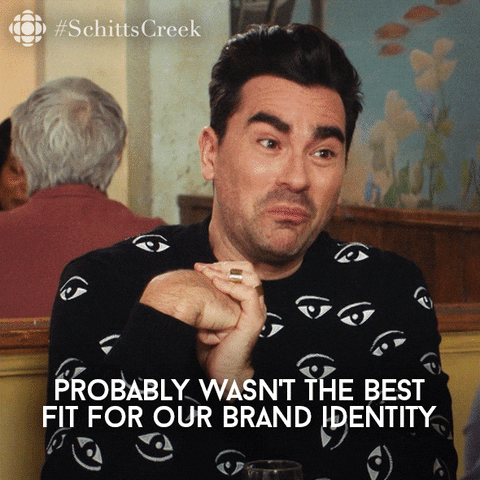Coaching Branding: Why It's (Almost) Always A Waste Of Time And Money
Pretty website, no clients.
That used to be me.
When I started my coaching business, I spent the first three weeks trying to think of a URL name. Three weeks.
Then I lost hours of sleep thinking about my website colors. Should I go with "Bittersweet shimmer" or "Atomic tangerine?"
I even considered paying a logo designer $862. For a name I never used.
Wanna guess how much money I made during this coaching branding escapade?
Zero dollars.
Shit coaches say while they go broke (via giphy)
Unfortunately, I can't go back in time and slap myself for spending three weeks on GoDaddy.com. But I can help you avoid the same fate.
What Coaching Branding Actually Means
Most people think a brand is your name, color scheme, and logo.
Not true.
My favorite definition of a brand is from Marty Neumeier. According to him, a brand is "A person's gut feeling about a product, service, or a company."
In other words, your brand is your reputation. It's defined by other people: your clients, audience members, and referral partners.
This is why focusing on your coaching brand early on is a waste of resources. To have a brand, you need to have clients. And clients come from marketing.
Yes, you should do your best to build a good reputation when you start off. But that will primarily be a result of the promises you make and how well you deliver on them.
3 Things For Coaches To Focus On Instead Of Personal Branding
When you start your business, your sole focus should be on getting results for paid clients. Here's what to do:
1. Clarify your niche
Your niche is different from your brand. It's the combination of who you coach and what you do for them. Any personal branding you do before clarifying your niche will end up changing down the line.
You don't need to narrow your niche right off the bat. When you're starting out, I recommend choosing one main problem to solve for people. Then you can hone in on a specific target market as you work with clients.
Here are 21 proven and profitable coaching niches to choose from.
I know you’re sick of being told to niche down. It gets old. But until you can describe what you do, you're not ready to focus on coaching branding.
2. Validate your business
This is a fancy way of saying: go get paying clients.
An easy way to do this is by putting out a Strategy Session Invite to your network. This is how I got my first 5 high-end clients. You don’t even need a website.
If you've already worked with a few paid clients, learn your Coaching Archetype and go from there.
“To have a brand, you need to have clients.
And clients come from marketing.”
Most business advice focuses on large businesses. If you're a Fortune 500 company, then sure, branding is important. But if you're making less than 6 figures, it's too early to worry about your brand.
3. Put together a simple website
I know what you're thinking: "At some point, I need to have an online presence."
True. But you don't need to spend $10,000 on a designer. Especially since most of them don't know how to build a site that converts.
Want some examples? Here are The 35 Best Coaching Websites.
Your logo and color scheme should be simple and easy to read. Get a professional-looking site up (I use Squarespace) and then get back to coaching.
How about coaching names? In most cases, I recommend using your own name as the URL. If your name is hard to pronounce or spell, follow these tips for naming your business:
The Only Brand Strategy I Recommend For Coaches
Okay, so there's one exception to my "No Personal Branding" rule.
Once you start explaining what you do, people will ask, "How did you get into that?" This is a great opportunity to share your story.
Storytelling is a coaching branding strategy that builds trust and credibility with potential clients. It’s the one strategy that’s worth focusing on, even in the early stages of your business. And it’s totally free.
You can use storytelling on your about page, in your content, and during live workshops. You can also use it to share client case studies. This is actually superior to telling your own story, since it makes your client the hero. It’s one thing for you to get results in your own life and quite another to help someone else do the same.
Storytelling demonstrates two things. First, that you understand where your potential clients are now (because you've been there). Second, that you know how to get them where they want to go (because you've done it yourself).
The best part? It does all this without being pushy. In fact, it builds curiosity and pulls the right clients closer to you.
To help you do this do this correctly, I've created a little worksheet with my 4-Step Story Blueprint. It includes a storytelling example from my own business.
Click the button below to download it now:
The Bottom Line On Branding Your Coaching Business
Branding is a luxury that you earn through getting clients.
Until people know you exist...
Until you can explain what you do and who you help...
Until you've gotten enough clients to validate your business...
There's no point in branding.
You already know that the font you use won’t make or break your business. If that's true, then why do you feel the need to spend so much time on branding?
Branding is a form of Creative Avoidance. It feels safe and it protects our ego. Branding allows us to feel productive without risking rejection.
The activities that get you clients are uncomfortable. If something doesn't scare you at first, it's probably not worth doing.
Note: Before you go, click below and download my 4 Step Storytelling Blueprint:


